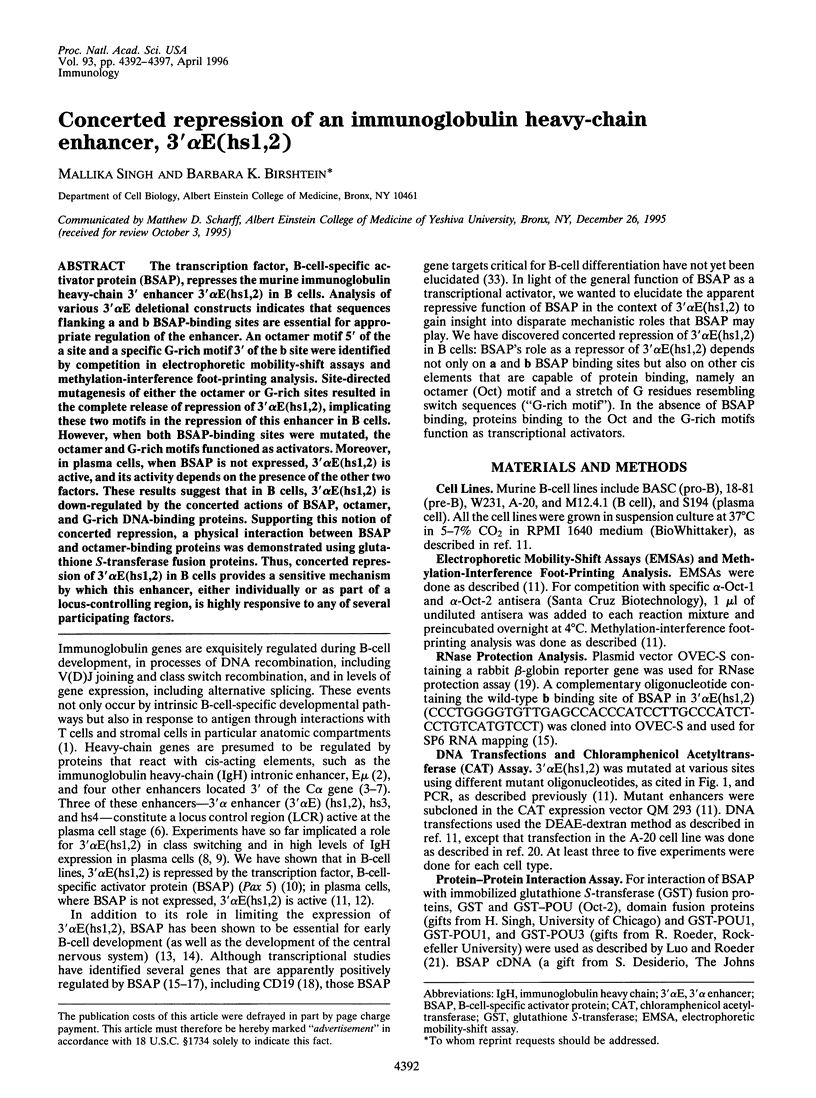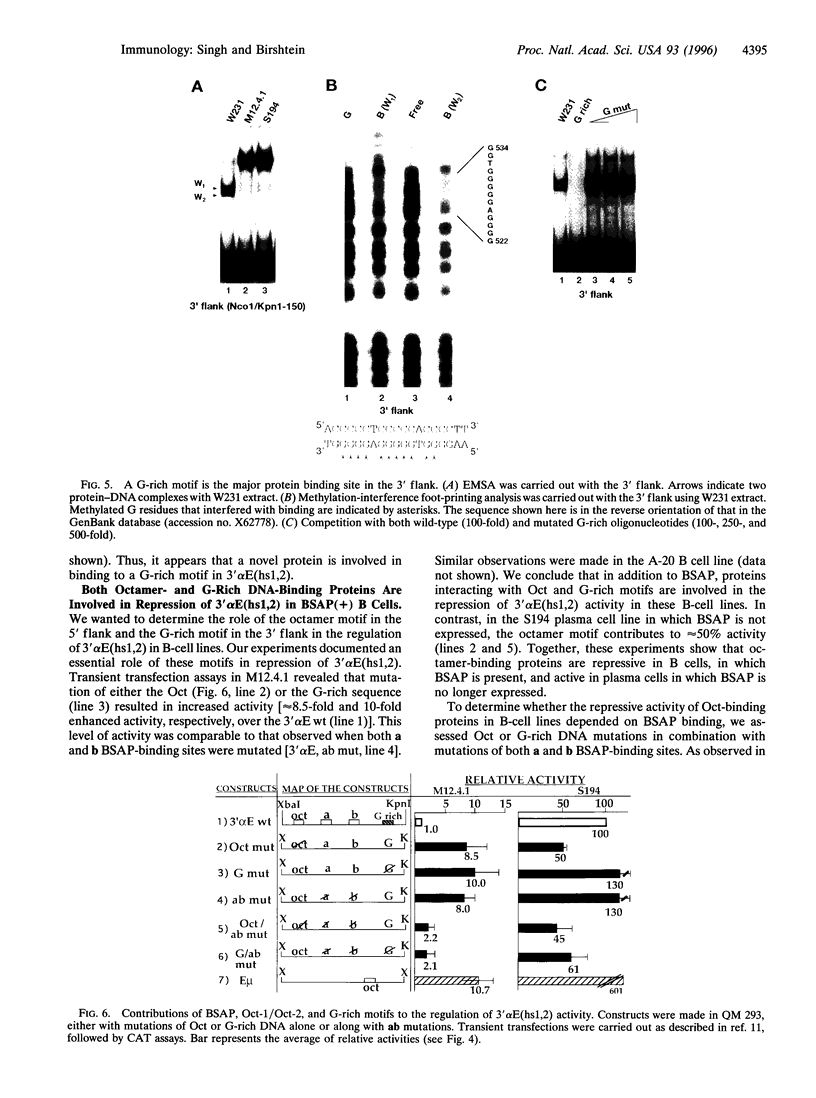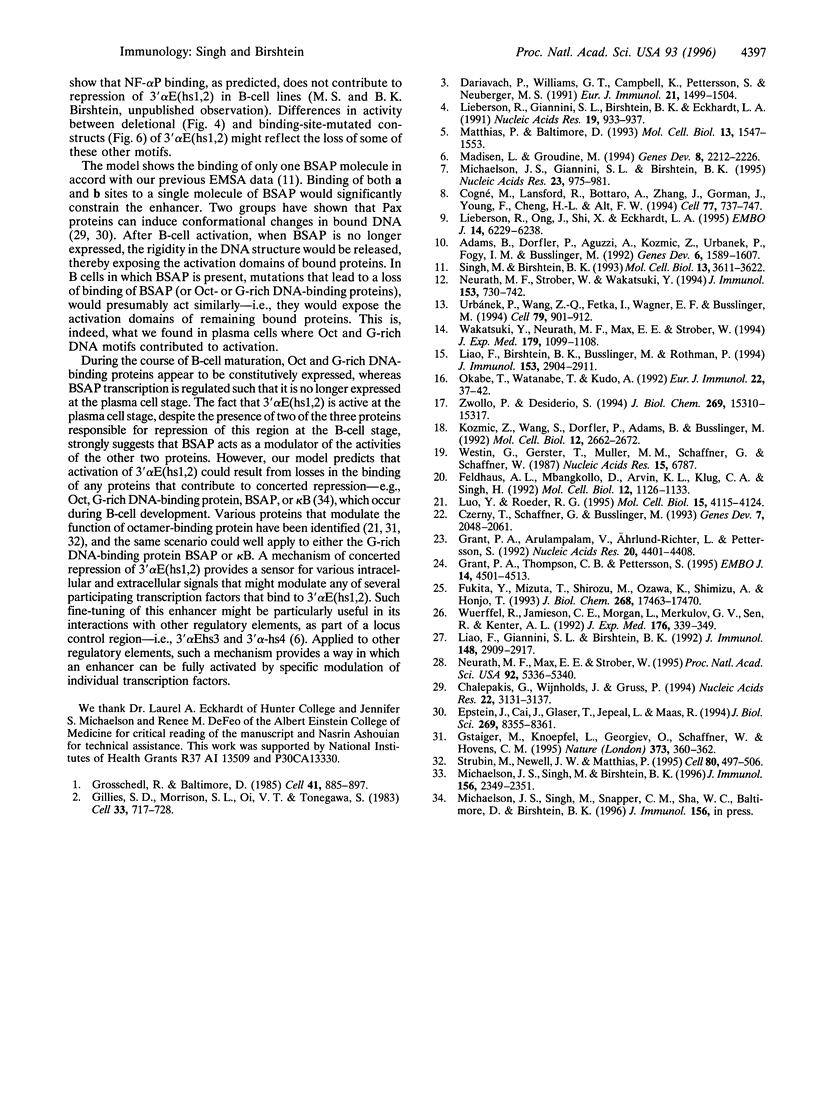Abstract
The transcription factor, B-cell-specific activator protein (BSAP), represses the murine immunoglobulin heavy-chain 3' enhancer 3' alpha E(hs1,2) in B cells. Analysis of various 3'alpha E deletional constructs indicates that sequences flanking a and b BSAP-binding sites are essential for appropriate regulation of the enhancer. An octamer motif 5' of the a site and a specific G-rich motif 3' of the b site were identified by competition in electrophoretic mobility-shift assays and methylation-interference foot-printing analysis. Site-directed mutagenesis of either the octamer or G-rich sites resulted in the complete release of repression of 3' alpha E(hs1,2), implicating these two motifs in the repression of this enhancer in B cells. However, when both BSAP-binding sites were mutated, the octamer and G-rich motifs functioned as activators. Moreover, in plasma cells, when BSAP is not expressed, 3' alpha E(hs1,2) is active, and its activity depends on the presence of the other two factors. These results suggest that in B cells, 3' alpha E (hs1,2) is down-regulated by the concerted actions of BSAP, octamer, and G-rich DNA-binding proteins. Supporting this notion of concerted repression, a physical interaction between BSAP and octamer-binding proteins was demonstrated using glutathione S-transferase fusion proteins. Thus, concerted repression of 3' alpha E (hs1,2) in B cells provides a sensitive mechanism by which this enhancer, either individually or as part of a locus-controlling region, is highly responsive to any of several participating factors.
Full text
PDF





Images in this article
Selected References
These references are in PubMed. This may not be the complete list of references from this article.
- Adams B., Dörfler P., Aguzzi A., Kozmik Z., Urbánek P., Maurer-Fogy I., Busslinger M. Pax-5 encodes the transcription factor BSAP and is expressed in B lymphocytes, the developing CNS, and adult testis. Genes Dev. 1992 Sep;6(9):1589–1607. doi: 10.1101/gad.6.9.1589. [DOI] [PubMed] [Google Scholar]
- Chalepakis G., Wijnholds J., Gruss P. Pax-3-DNA interaction: flexibility in the DNA binding and induction of DNA conformational changes by paired domains. Nucleic Acids Res. 1994 Aug 11;22(15):3131–3137. doi: 10.1093/nar/22.15.3131. [DOI] [PMC free article] [PubMed] [Google Scholar]
- Cogné M., Lansford R., Bottaro A., Zhang J., Gorman J., Young F., Cheng H. L., Alt F. W. A class switch control region at the 3' end of the immunoglobulin heavy chain locus. Cell. 1994 Jun 3;77(5):737–747. doi: 10.1016/0092-8674(94)90057-4. [DOI] [PubMed] [Google Scholar]
- Czerny T., Schaffner G., Busslinger M. DNA sequence recognition by Pax proteins: bipartite structure of the paired domain and its binding site. Genes Dev. 1993 Oct;7(10):2048–2061. doi: 10.1101/gad.7.10.2048. [DOI] [PubMed] [Google Scholar]
- Dariavach P., Williams G. T., Campbell K., Pettersson S., Neuberger M. S. The mouse IgH 3'-enhancer. Eur J Immunol. 1991 Jun;21(6):1499–1504. doi: 10.1002/eji.1830210625. [DOI] [PubMed] [Google Scholar]
- Epstein J., Cai J., Glaser T., Jepeal L., Maas R. Identification of a Pax paired domain recognition sequence and evidence for DNA-dependent conformational changes. J Biol Chem. 1994 Mar 18;269(11):8355–8361. [PubMed] [Google Scholar]
- Feldhaus A. L., Mbangkollo D., Arvin K. L., Klug C. A., Singh H. BLyF, a novel cell-type- and stage-specific regulator of the B-lymphocyte gene mb-1. Mol Cell Biol. 1992 Mar;12(3):1126–1133. doi: 10.1128/mcb.12.3.1126. [DOI] [PMC free article] [PubMed] [Google Scholar]
- Fukita Y., Mizuta T. R., Shirozu M., Ozawa K., Shimizu A., Honjo T. The human S mu bp-2, a DNA-binding protein specific to the single-stranded guanine-rich sequence related to the immunoglobulin mu chain switch region. J Biol Chem. 1993 Aug 15;268(23):17463–17470. [PubMed] [Google Scholar]
- Gillies S. D., Morrison S. L., Oi V. T., Tonegawa S. A tissue-specific transcription enhancer element is located in the major intron of a rearranged immunoglobulin heavy chain gene. Cell. 1983 Jul;33(3):717–728. doi: 10.1016/0092-8674(83)90014-4. [DOI] [PubMed] [Google Scholar]
- Grant P. A., Arulampalam V., Ahrlund-Richter L., Pettersson S. Identification of Ets-like lymphoid specific elements within the immunoglobulin heavy chain 3' enhancer. Nucleic Acids Res. 1992 Sep 11;20(17):4401–4408. doi: 10.1093/nar/20.17.4401. [DOI] [PMC free article] [PubMed] [Google Scholar]
- Grant P. A., Thompson C. B., Pettersson S. IgM receptor-mediated transactivation of the IgH 3' enhancer couples a novel Elf-1-AP-1 protein complex to the developmental control of enhancer function. EMBO J. 1995 Sep 15;14(18):4501–4513. doi: 10.1002/j.1460-2075.1995.tb00129.x. [DOI] [PMC free article] [PubMed] [Google Scholar]
- Grosschedl R., Baltimore D. Cell-type specificity of immunoglobulin gene expression is regulated by at least three DNA sequence elements. Cell. 1985 Jul;41(3):885–897. doi: 10.1016/s0092-8674(85)80069-6. [DOI] [PubMed] [Google Scholar]
- Gstaiger M., Knoepfel L., Georgiev O., Schaffner W., Hovens C. M. A B-cell coactivator of octamer-binding transcription factors. Nature. 1995 Jan 26;373(6512):360–362. doi: 10.1038/373360a0. [DOI] [PubMed] [Google Scholar]
- Kozmik Z., Wang S., Dörfler P., Adams B., Busslinger M. The promoter of the CD19 gene is a target for the B-cell-specific transcription factor BSAP. Mol Cell Biol. 1992 Jun;12(6):2662–2672. doi: 10.1128/mcb.12.6.2662. [DOI] [PMC free article] [PubMed] [Google Scholar]
- Liao F., Birshtein B. K., Busslinger M., Rothman P. The transcription factor BSAP (NF-HB) is essential for immunoglobulin germ-line epsilon transcription. J Immunol. 1994 Mar 15;152(6):2904–2911. [PubMed] [Google Scholar]
- Liao F., Giannini S. L., Birshtein B. K. A nuclear DNA-binding protein expressed during early stages of B cell differentiation interacts with diverse segments within and 3' of the Ig H chain gene cluster. J Immunol. 1992 May 1;148(9):2909–2917. [PubMed] [Google Scholar]
- Lieberson R., Giannini S. L., Birshtein B. K., Eckhardt L. A. An enhancer at the 3' end of the mouse immunoglobulin heavy chain locus. Nucleic Acids Res. 1991 Feb 25;19(4):933–937. doi: 10.1093/nar/19.4.933. [DOI] [PMC free article] [PubMed] [Google Scholar]
- Lieberson R., Ong J., Shi X., Eckhardt L. A. Immunoglobulin gene transcription ceases upon deletion of a distant enhancer. EMBO J. 1995 Dec 15;14(24):6229–6238. doi: 10.1002/j.1460-2075.1995.tb00313.x. [DOI] [PMC free article] [PubMed] [Google Scholar]
- Luo Y., Roeder R. G. Cloning, functional characterization, and mechanism of action of the B-cell-specific transcriptional coactivator OCA-B. Mol Cell Biol. 1995 Aug;15(8):4115–4124. doi: 10.1128/mcb.15.8.4115. [DOI] [PMC free article] [PubMed] [Google Scholar]
- Madisen L., Groudine M. Identification of a locus control region in the immunoglobulin heavy-chain locus that deregulates c-myc expression in plasmacytoma and Burkitt's lymphoma cells. Genes Dev. 1994 Sep 15;8(18):2212–2226. doi: 10.1101/gad.8.18.2212. [DOI] [PubMed] [Google Scholar]
- Matthias P., Baltimore D. The immunoglobulin heavy chain locus contains another B-cell-specific 3' enhancer close to the alpha constant region. Mol Cell Biol. 1993 Mar;13(3):1547–1553. doi: 10.1128/mcb.13.3.1547. [DOI] [PMC free article] [PubMed] [Google Scholar]
- Michaelson J. S., Giannini S. L., Birshtein B. K. Identification of 3' alpha-hs4, a novel Ig heavy chain enhancer element regulated at multiple stages of B cell differentiation. Nucleic Acids Res. 1995 Mar 25;23(6):975–981. doi: 10.1093/nar/23.6.975. [DOI] [PMC free article] [PubMed] [Google Scholar]
- Michaelson J. S., Singh M., Birshtein B. K. B cell lineage-specific activator protein (BSAP). A player at multiple stages of B cell development. J Immunol. 1996 Apr 1;156(7):2349–2351. [PubMed] [Google Scholar]
- Neurath M. F., Max E. E., Strober W. Pax5 (BSAP) regulates the murine immunoglobulin 3' alpha enhancer by suppressing binding of NF-alpha P, a protein that controls heavy chain transcription. Proc Natl Acad Sci U S A. 1995 Jun 6;92(12):5336–5340. doi: 10.1073/pnas.92.12.5336. [DOI] [PMC free article] [PubMed] [Google Scholar]
- Neurath M. F., Strober W., Wakatsuki Y. The murine Ig 3' alpha enhancer is a target site with repressor function for the B cell lineage-specific transcription factor BSAP (NF-HB, S alpha-BP). J Immunol. 1994 Jul 15;153(2):730–742. [PubMed] [Google Scholar]
- Okabe T., Watanabe T., Kudo A. A pre-B- and B cell-specific DNA-binding protein, EBB-1, which binds to the promoter of the VpreB1 gene. Eur J Immunol. 1992 Jan;22(1):37–43. doi: 10.1002/eji.1830220107. [DOI] [PubMed] [Google Scholar]
- Singh M., Birshtein B. K. NF-HB (BSAP) is a repressor of the murine immunoglobulin heavy-chain 3' alpha enhancer at early stages of B-cell differentiation. Mol Cell Biol. 1993 Jun;13(6):3611–3622. doi: 10.1128/mcb.13.6.3611. [DOI] [PMC free article] [PubMed] [Google Scholar]
- Strubin M., Newell J. W., Matthias P. OBF-1, a novel B cell-specific coactivator that stimulates immunoglobulin promoter activity through association with octamer-binding proteins. Cell. 1995 Feb 10;80(3):497–506. doi: 10.1016/0092-8674(95)90500-6. [DOI] [PubMed] [Google Scholar]
- Urbánek P., Wang Z. Q., Fetka I., Wagner E. F., Busslinger M. Complete block of early B cell differentiation and altered patterning of the posterior midbrain in mice lacking Pax5/BSAP. Cell. 1994 Dec 2;79(5):901–912. doi: 10.1016/0092-8674(94)90079-5. [DOI] [PubMed] [Google Scholar]
- Wakatsuki Y., Neurath M. F., Max E. E., Strober W. The B cell-specific transcription factor BSAP regulates B cell proliferation. J Exp Med. 1994 Apr 1;179(4):1099–1108. doi: 10.1084/jem.179.4.1099. [DOI] [PMC free article] [PubMed] [Google Scholar]
- Westin G., Gerster T., Müller M. M., Schaffner G., Schaffner W. OVEC, a versatile system to study transcription in mammalian cells and cell-free extracts. Nucleic Acids Res. 1987 Sep 11;15(17):6787–6798. doi: 10.1093/nar/15.17.6787. [DOI] [PMC free article] [PubMed] [Google Scholar]
- Wuerffel R., Jamieson C. E., Morgan L., Merkulov G. V., Sen R., Kenter A. L. Switch recombination breakpoints are strictly correlated with DNA recognition motifs for immunoglobulin S gamma 3 DNA-binding proteins. J Exp Med. 1992 Aug 1;176(2):339–349. doi: 10.1084/jem.176.2.339. [DOI] [PMC free article] [PubMed] [Google Scholar]
- Zwollo P., Desiderio S. Specific recognition of the blk promoter by the B-lymphoid transcription factor B-cell-specific activator protein. J Biol Chem. 1994 May 27;269(21):15310–15317. [PubMed] [Google Scholar]








